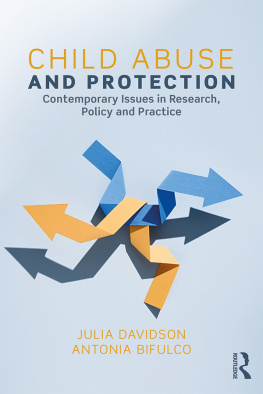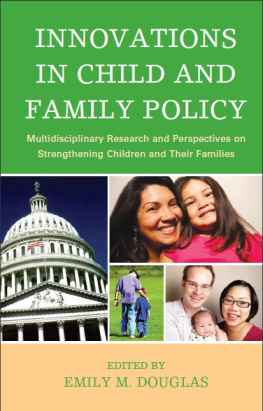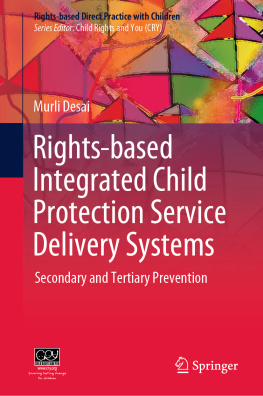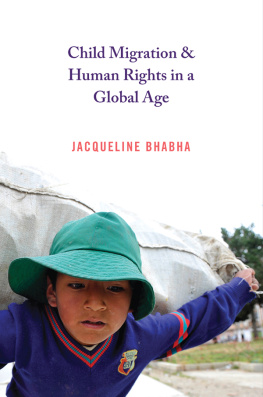First published in Great Britain in 2018 by
Policy Press University of Bristol 1-9 Old Park Hill Bristol BS2 8BB UK Tel +44 (0)117 954 5940 e-mail
North American office: Policy Press c/o The University of Chicago Press 1427 East 60th Street Chicago, IL 60637, USA t: +1 773 702 7700 f: +1 773-702-9756 e:
Policy Press 2018
British Library Cataloguing in Publication Data
A catalogue record for this book is available from the British Library
Library of Congress Cataloging-in-Publication Data
A catalog record for this book has been requested
ISBN 978-1-4473-3275-6 paperback
ISBN 978-1-4473-3273-2 hardcover
ISBN 978-1-4473-3276-3 ePub
ISBN 978-1-4473-3277-0 Mobi
ISBN 978-1-4473-3274-9 ePdf
The right of Brid Featherstone, Anna Gupta, Kate Morris and Sue White to be identified as authors of this work has been asserted by them in accordance with the Copyright, Designs and Patents Act 1988.
All rights reserved: no part of this publication may be reproduced, stored in a retrieval system, or transmitted in any form or by any means, electronic, mechanical, photocopying, recording, or otherwise without the prior permission of Policy Press.
The statements and opinions contained within this publication are solely those of the authors and not of the University of Bristol or Policy Press. The University of Bristol and Policy Press disclaim responsibility for any injury to persons or property resulting from any material published in this publication.
Policy Press works to counter discrimination on grounds of gender, race, disability, age and sexuality.
Cover design by Robin Hawes
Front cover image: www.alamy.com
Reader's Guide
This book has been optimised for PDA.
Tables may have been presented to accommodate this devices' limitations.
Image presentation is limited by this device's limitations.
ONE
Introduction
In 2014 Re-imagining Child Protection: Towards Humane Social Work with Families (Featherstone, White and Morris, 2014) was published. It was greeted with great interest and there was an overwhelmingly positive response to the critical review it undertook of contemporary child protection and its plea for humane practice. It resonated with practitioners and policy makers alike and suggested simply doing more of the same was neither ethical nor practicable. The book concluded by arguing for change in order to create policies and practices that inspired hope.
Many would argue that the problems have become more, not less, acute in the intervening period and the anxieties about the future set out in Re-imagining Child Protection have become more fully realised in the context of continued austerity and its disproportionate focus and impact on deprived families and local authorities. However, there have been also been more hopeful developments, including new empirical work that increases our understandings, innovations in practice that push at the constraints of the existing child protection project and fresh alliances seeking change. Using these positive developments this book is concerned with moving the discussion forward, and with seeking to provoke conceptual and applied debates that might offer children and families a more hopeful future when they face problems, uncertainties and harm.
Telling a new story
George Monbiot (2017: 1) argues that '[y] ou cannot take away someone's story without giving them a new one. It is not enough to challenge an old narrative, however outdated and discredited it may be. Change happens only when you replace it with another.' In this book we tell a new story, but one that has familiar chapters, rooted in social work's history. It is informed by our ethical positions and our research, and is encouraged by our engagement with those who experience current systems, and those who work in them. Like all good stories, there is room in the telling for different voices to chip in, add, challenge and, indeed, revise. Thus, while we consider the book contains much of what is needed to get us started on the road to transformation, it is only the start. As we go along, we identify what needs to change, why and how, but we also highlight the allies and conversations needed for the next steps.
As the activist, Rebecca Solnit notes:
Changing the story isn't enough in itself, but it has often been foundational to real changes. Making an injury visible and public is usually the first step in remedying it, and political change often follows culture, as what was long tolerated is seen to be intolerable, or what was overlooked becomes obvious. Which means that every conflict is in part a battle over the story we tell, or who tells and who is heard. (2016: xiv, our emphasis)
Thus, a crucial part of our project is to expand and legitimise opportunities for different types of dialogue, storytellers and audiences. In particular, we highlight the importance of dialogue between those who experience services and those who design them, and, crucially, between those, who do not see the importance of linking actions to protect children with those concerned to tackle inequalities and social isolation, and those who give the dynamic relations between the two a more central place.
Locating our story
Across many countries, including the UK, the settlement between the state and its citizens, forged post war, has been undermined, if not broken, by a variety of economic and social developments (Davies, 2017). Increasingly, citizens' expectations of decent work, secure and affordable housing, and enough to eat can no longer be guaranteed by a state that is experienced as both intrusive and neglectful, especially by the poor, with a subsequent loss of trust and widespread feelings of alienation and disconnection (Davies, 2017, Monbiot, 2017, Peston, 2017).
A key argument of this book is that the policies and practices that have been developed to protect children need to be understood and located within this wider canvas and, indeed, have come to exemplify a punitive and neglectful state in many respects. This is deeply distressing given the enormous amount of effort and good will extended by a very wide range of constituencies to keeping children safe and making systems work. But in this book we suggest it is vital that we interrogate the history of such efforts and their intimate intersection with wider social policies and social trends (see Parton, 1985, 1991). In this Introduction we offer a brief highlight but provide a much more thorough engagement with past, present and, indeed if we continue on our present trajectory, future dangers and possibilities.
The modern child protection system emerged in the 1960s rooted in a concern to stop babies dying or being 'battered' by parents, who were considered to be suffering from a lack of empathic mothering in their own lives. Poverty, bad housing and other social factors were screened out as holding helpful explanatory value in relation to why some babies were seriously harmed by their carers (Parton, 1985). It was considered that the post-war welfare settlement provided for the basic needs (such as income, housing, health care and education) of the majority of citizens, but there were some who were damaged by earlier psychological experiences and needed therapeutic help to care safely.







